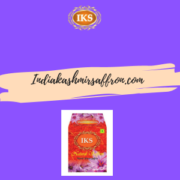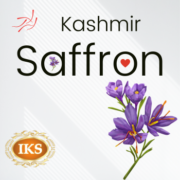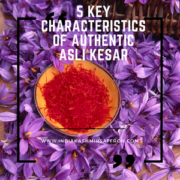How to Identify Pure Saffron: A Comprehensive Guide
How to Identify Pure Saffron – Introduction
How to Identify Pure Saffron – Saffron, often referred to as the “golden spice,” is one of the most expensive and sought-after spices in the world. Derived from the delicate stigma of the Crocus sativus flower, saffron is prized for its unique flavor, vibrant color, and medicinal properties.
However, due to its high value, saffron is often adulterated or counterfeited, making it crucial to know how to identify pure saffron. This article will guide you through the various methods to ensure the saffron you purchase is genuine, helping you enjoy the full benefits of this exquisite spice.
Ensure Authenticity: Buy Pure Saffron from Trusted Sources Today!
Understanding Saffron’s Origins
History and Cultivation
Saffron has a rich history dating back over 3,000 years, with origins in the Middle East, particularly in Iran, Greece, and India. It is cultivated mainly in Iran, India (particularly Kashmir), Spain, and Greece.
The labor-intensive harvesting process, where each flower must be handpicked, contributes to saffron’s high cost. Typically, 75,000 saffron flowers are needed to produce just one pound of saffron.
Characteristics of Pure Saffron
Pure saffron has three key components that give it its unique qualities: crocin (color), picrocrocin (taste), and safranal (aroma). These compounds are responsible for saffron’s intense color, distinctive taste, and aromatic fragrance.
Physical Examination
Appearance
One of the first steps in identifying pure saffron is examining its appearance. Genuine saffron threads are trumpet-shaped and about 2-3 cm in length. Each thread should be thin and uniformly red with a slightly darker red or orange tip. Saffron that appears too uniform in color or shape may be adulterated.
Color
When purchasing saffron, ensure that it has a deep red color. However, it’s important to note that pure saffron will not be uniformly colored. The presence of slightly lighter orange or yellow tips is a good sign. Be wary of saffron that appears bright red without any color variation, as this may indicate artificial coloring.
Aroma
Pure saffron has a distinctive, pungent aroma that is a combination of honey and hay-like scent. If the saffron lacks this characteristic fragrance or has an artificial or chemical smell, it is likely not genuine.
Discover the Difference: Purchase Genuine Saffron Now!
Chemical Tests
The Water Test
One of the simplest methods to test the purity of saffron is the water test. Follow these steps:
- Place a few saffron threads in a glass of warm water.
- Allow it to steep for about 10-15 minutes.
Observations:
- Color Release: Pure saffron will gradually release its color into the water, turning it a rich golden-yellow hue. The threads should not lose their color or turn white. If the water turns red or the threads immediately lose their color, it indicates artificial coloring.
- Aroma: Genuine saffron will release a pleasant aroma. If there is no fragrance, or if the aroma is off or chemical-like, it may not be pure.
The Vinegar Test
This test helps identify if the saffron has been artificially dyed. Follow these steps:
- Mix a small amount of vinegar with water in a glass.
- Add a few saffron threads to the mixture.
Observations:
- Color Change: Pure saffron will not significantly change color in vinegar. If the mixture changes color rapidly, it is a sign of artificial dye.
The Baking Soda Test
This test can help identify synthetic saffron:
- Add a pinch of baking soda to a glass of water.
- Add a few saffron threads to the mixture.
Observations:
- Color Change: Pure saffron will turn the water yellow. If the water turns any other color, it indicates adulteration.
Invest in Quality: Buy 100% Pure Saffron Today!
Sensory Evaluation
Taste
Pure saffron has a slightly bitter taste. If the saffron you have tastes sweet or has no taste, it may not be genuine.
Texture
Genuine saffron threads are dry and brittle. They should break easily when rubbed between your fingers. If the threads feel soft or sticky, they may be of poor quality or adulterated.
Purchasing Tips
Buy from Reputable Sources
One of the best ways to ensure you are buying pure saffron is to purchase it from reputable sources.
Look for well-known brands like IKS Saffron or trusted suppliers who have a track record of providing high-quality saffron.
Check for Certifications
Reputable saffron producers often provide certifications indicating the purity and quality of their product.
Look for labels such as FSSAI certification, which ensures that the saffron meets international standards.
Packaging
High-quality saffron is usually sold in sealed paper pouch packaging to preserve its freshness and potency.
Avoid purchasing saffron that is sold in open or poorly sealed packaging, as it may lose its quality over time.
Price
While it may be tempting to go for cheaper options, remember that genuine saffron is one of the most expensive spices in the world.
If the price seems too good to be true, it probably is. Investing in high-quality saffron ensures you get the full benefits of this precious spice.
Guarantee Purity: Order Genuine Saffron Online Now!
Storing Saffron
Proper storage is essential to maintain the quality and potency of saffron. Follow these tips for storing saffron:
Airtight Containers
Store saffron in airtight containers to protect it from exposure to air, moisture, and light. This helps preserve its color, aroma, and flavor.
Cool, Dark Place
Keep the saffron in a cool, dark place, such as a pantry or cupboard, away from direct sunlight and heat. This helps prevent the saffron from losing its potency over time.
Avoid Refrigeration
While it may seem logical to store saffron in the refrigerator, this can actually cause it to absorb moisture and lose its quality. Room temperature storage in a cool, dark place is ideal.
Common Adulterants
Safflower
Safflower is often used to adulterate saffron because it has a similar appearance. However, safflower lacks the unique flavor, aroma, and medicinal properties of genuine saffron. It can be identified by its slightly different color and lack of aroma.
Turmeric
Turmeric is another common adulterant due to its vibrant color. However, turmeric has a distinct earthy flavor and aroma, which can be easily distinguished from saffron. Additionally, turmeric powder lacks the thread-like structure of saffron.
Artificial Dyes
Artificial dyes are sometimes used to enhance the color of saffron. These dyes can be identified through chemical tests, as they tend to dissolve quickly and completely in water, leaving no residue.
Conclusion – How to Identify Pure Saffron
Identifying pure saffron is crucial to ensure you are getting the full benefits of this exquisite spice. By understanding the characteristics of genuine saffron, performing physical and chemical tests, and purchasing from reputable sources, you can confidently select high-quality saffron for your culinary and medicinal needs.
Proper storage and awareness of common adulterants further ensure that your saffron remains potent and pure. Embrace the rich flavor, vibrant color, and health benefits of pure saffron with the knowledge and tools provided in this guide.
Don’t Compromise: Buy Pure Saffron and Taste the Excellence!






 WHAT EXACTLY IS ORGANIC SAFFRON? Types of Saffron.
WHAT EXACTLY IS ORGANIC SAFFRON? Types of Saffron.






Leave a Reply
Want to join the discussion?Feel free to contribute!